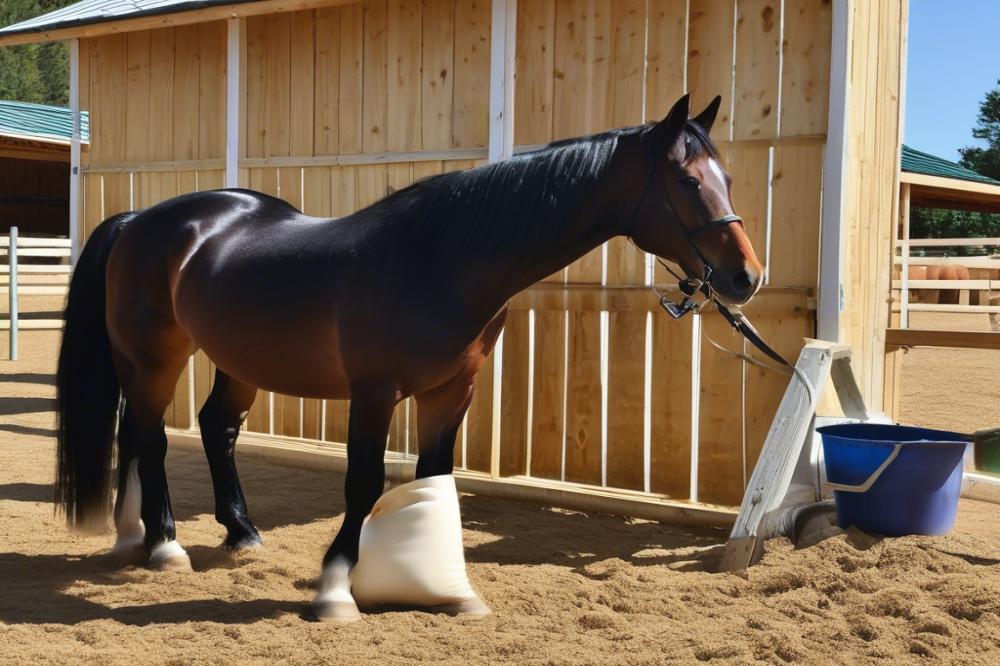Understanding PSSM in Horses
Horse care can sometimes feel like solving a puzzle, especially when it comes to equine issues like polysaccharide storage myopathy, commonly known as PSSM. This muscular disorder affects how a horse stores and uses certain carbohydrates. As a result, affected horses can experience muscle stiffness, cramping, and on occasion, even a good old-fashioned case of the “thumps” after exercise. It’s no surprise that these symptoms can have a real impact on a horse’s overall wellbeing and performance. Just like the unique temperament of an Akhal-Teke, which is known for its spirited nature, horses with PSSM can be quirky and need special attention.
Why Proper Feeding Matters

It’s vital to understand that proper horse feeding becomes a key player in managing PSSM. Maintaining a correct diet allows these beautiful creatures to thrive despite their condition. A well-planned PSSM diet not only helps in alleviating symptoms but also supports horse health and performance. Imagine trying to ride a racehorse on a diet of hay and water; that wouldn’t end well, right? Just like any athlete, horses need the right fuel to perform at their best. Each bite they take matters, so getting it right can be the difference between a good ride and a great ride.
One could argue that diet is like a key to a treasure chest filled with energy and vitality. A horse that is properly fed can enjoy a comfortable life, avoiding the pitfalls of muscle pain and fatigue. On the flip side, inadequate nutrition can lead to a cascade of issues—much like when you forget to charge your phone and miss important calls! So, whether you’re pondering the question, “can a horse be a pet?”, or simply thinking about how to keep your equine companion in tip-top shape, understanding the right approach to equine nutrition is fundamental.
As we delve into the specifics of feeding horses with PSSM, remember that caring for these magnificent animals requires a bit of knowledge, a dash of patience, and sometimes, a sense of humor. After all, every horse has its quirks, and learning how to navigate the complexities of their needs can be quite the adventure!
Understanding PSSM

Definition of Polysaccharide Storage Myopathy
Polysaccharide Storage Myopathy, or PSSM, is a muscle disorder that affects horses. It occurs when the horse’s body stores too much sugar in their muscles. This extra sugar can cause problems, especially during exercise. Horses with PSSM may struggle to perform tasks they once tackled with ease. Knowing how to adjust your horse’s diet is crucial for managing this condition effectively.
Signs and Symptoms of PSSM in Horses
Recognizing the signs of PSSM can be tricky at times. Owners often notice stiffness in their horse after exercise. A horse may also show signs of muscle cramps or pain. In some cases, they might have difficulty moving around. Some horses even appear to be reluctant to engage in physical activity. Owners might see their horse sweating more than usual, even when not working hard. Monitoring your animal closely can help in identifying these signs earlier, allowing for better horse care.
Types of PSSM and Their Implications for Feeding
There are two main types of PSSM: Type 1 and Type 2. Type 1 is genetic, meaning it’s inherited from the parents. This form can make horse feeding a bit more complex. Type 2, on the other hand, does not have a known genetic link but still leads to significant muscle issues. Both types, however, benefit from a careful look at the equine diet.
When it comes to feeding horses with PSSM, avoiding rich carbohydrates is vital. High-starch feeds can worsen muscle soreness and discomfort. Instead, focus on low-starch options that provide the necessary nutrients without the added sugars. Additionally, including quality forage is essential. Hay and grass diets work wonders for overall equine nutrition.
It’s also beneficial to think about supplemental vitamins and minerals. Sometimes, a little extra help can support horse health during this condition. Always consult with a veterinarian or a horse nutritionist to create tailored meal plans. They can provide the best advice, ensuring the horse gets the right balance without the risk of worsening PSSM symptoms.
Think of it this way: proper feeding is like having the right fuel for a car. You wouldn’t put regular gas into a sports car expecting it to race smoothly. The same goes for horses—the right diet paves the way for happier, healthier animals living their best lives despite PSSM.
Nutritional Needs of Horses with PSSM

Key Dietary Components for Horses with PSSM
Feeding horses with PSSM can feel like walking a tightrope. Balancing their nutrition is essential for their overall health. Each horse is different. Some might tolerate certain foods better than others. That’s why it’s crucial to understand their unique dietary needs, especially when it comes to carbohydrates, fats, and proteins.
Role of Carbohydrates, Fats, and Proteins
Carbohydrates often get a bad rap. For horses with PSSM, the type of carbs consumed makes all the difference. High-starch feeds can cause trouble. Instead, opt for low-starch options. These can help your horse avoid unnecessary muscle discomfort and other problems.
When it comes to fats, these are your friend. Oils and fat sources serve as energy without spiking blood sugar levels. They are beneficial for maintaining a healthy weight and muscle condition. Including fats can also make a feed more palatable. Just remember, moderation is key.
Now, let’s talk proteins. These building blocks help with muscle repair and overall body maintenance. Horses need a good source of quality protein in their equine diet, but be careful with the amounts. Too much can lead to other issues.
Importance of Vitamins and Minerals
Vitamins and minerals act like the secret sauce in a good recipe. They support your horse’s immune system and help keep everything running smoothly. Magnesium is particularly important for horses with PSSM. It can aid muscle function and help control insulin levels.
Calcium and phosphorus should also be part of their daily intake. A balance of these two minerals supports strong bones and muscles. Electrolytes play a role as well, especially in hot weather when your horse sweats. Staying hydrated and replenishing lost electrolytes can be key to preventing muscle cramps.
When adjusting an equine diet for a horse with PSSM, it helps to work with a veterinarian or an equine nutritionist. They can guide you to ensure your horse receives all essential nutrients. Remember, horse care goes beyond just feeding. It’s about building a lifestyle that keeps them happy and healthy.
Creating a Feeding Plan
Feeding a horse with PSSM involves careful planning. An equine diet needs to cater to their specific needs. Start by focusing on forage. Quality forage forms the backbone of their diet.
Guidelines for Formulating a Diet for PSSM Horses
Know the basics: a horse’s diet should be low in sugar and starch. This helps manage their symptoms. Choosing hays that are lower in carbohydrates is essential. Grass hay is often better than clover or alfalfa, which can be richer in sugars. Testing your hay for nutritional quality can be a smart move. Better to know than guess!
Monitoring body condition is important too. It’s more than just looks; it’s about overall well-being. Watch for any signs of muscle stiffness or cramping. Adjust the feeding plan as necessary to maintain an ideal weight. Your horse’s energy levels can change, and you might need to tweak things along the way.
Recommended Forage Types and Amounts
When it comes to forage, consider using timothy hay or orchard grass. These types are typically easier on their sensitive systems. Aim for a minimum of 1.5% of the horse’s body weight in forage daily. For a standard horse weighing 1000 pounds, that equals about 15 pounds of hay. Providing plenty of forage keeps their digestive system happy.
Don’t forget, horses are nature’s grazing machines. They can eat small amounts throughout the day. If possible, a slow feeder can help mimic natural grazing. It’s like giving them a buffet that lasts all day!
Balancing Concentrates and Supplements
Concentrates may be necessary, but choose wisely. Look for low-starch feeds specifically made for PSSM horses. Pelleted products can provide necessary energy without the risk of sugar spikes. Always check the label for carbohydrate content.
Adding supplements can also play a role in their diet. Omega-3 fatty acids, for instance, support healthy muscle function and reduce inflammation. A proper balance is crucial. Even a pinch of the wrong thing can tip the scales!
Last but not least, don’t forget about water! Hydration is key for digestion and muscle health. Make sure fresh, clean water is always available. After all, even the best diet won’t help if your horse isn’t drinking enough.
Foods to Include
Best Grains and Feeds for Horses with PSSM
When considering what to feed a horse with PSSM, grains become a big topic of discussion. You’ll want to avoid high-starch grains like oats or corn. Instead, think about options that are easier on their muscles. A great choice is beet pulp. It’s fibrous, low in starch, and horses tend to love it!
You might also explore alfalfa hay. It provides good protein without lots of sugar. Pelleted feeds designed specifically for horses with PSSM can also help. They often have the right blend of nutrients. Keep an eye out for formulas that highlight low starch content as key.
High-Fat and Low-Starch Options
Avoiding starch isn’t the only thing to keep in mind. High-fat feeds can really benefit these horses too, providing extra calories without adding sugar. Look for oils like flaxseed or canola oil. Just a little can make a big difference.
Commercial feeds labeled as “low-starch” are a smart purchase, as they often feature higher fat levels. This can keep your horse looking good while staying healthy. Some folks even add coconut oil to their horses’ meals. It’s a tasty treat with healthy fats!
Recommended Supplements that Support Muscle Function
Supplements can be a helpful part of horse care for those dealing with PSSM. Magnesium is well known for promoting muscle relaxation. Some owners have reported that adding a magnesium supplement can really help in muscle function.
Another great addition is Vitamin E. This vitamin is essential for muscle health and can help reduce muscle-related issues. If you want to go the extra mile, consider a muscle support supplement. They usually contain a mix of amino acids and antioxidants, which can work wonders for horse health.
Horses are unique creatures that thrive on proper equine nutrition. Don’t be afraid to mix and match some of these options to find what works for your horse. After all, every horse has its own preferences, just like us! Keep an eye on their reactions and adapt as needed. Happy feeding!
Foods to Avoid
When caring for a horse with PSSM, certain foods can make things worse. You want to steer clear of high-sugar and high-starch options. These can lead to increased muscle soreness and fatigue. Let’s navigate this tricky landscape together.
Common Feeds That Worsen PSSM Symptoms
Certain grains are notorious for their high carbohydrate content. Some common culprits include oats and corn. Feeding these may seem harmless, but they can trigger unwanted symptoms. If your horse munches on sweet feeds, it could cause trouble. Packed with molasses, these mixes sound tasty, yet they’re not your friend in the PSSM world.
Understanding Sugar and Starch Content
Digging deeper, sugar and starch are sneaky little devils hiding in many feeds. It’s essential to read ingredient labels closely. A horse’s body reacts to too much sugar in ways we don’t want to see. Look for feeds that have low levels of both substances. A simple rule to follow is this: if it looks sugary or shiny, it’s probably not ideal.
Signs to Watch for When Selecting Feeds
When picking out the right food for your horse, be vigilant. Watch for any signs of distress after a new diet change. If your horse seems more fatigued than usual or shows signs of muscle stiffness, it might be time to rethink what’s in the feed bucket. It’s like a puzzle; each piece matters. Keeping a journal of what works and what doesn’t can also help track your horse’s responses.
In summary, feeding horses with PSSM requires some careful thought. Your equine’s diet should be balanced and low in sugar and starch. Combine that with regular check-ins on how your horse is feeling. A little caution today can lead to a healthier tomorrow for your four-legged friend.
Monitoring and Adjusting the Diet
Feeding a horse with PSSM is not just about throwing hay in a trough and calling it a day. Close attention to their condition is vital. Regular check-ins on your horse’s health and behavior can help guide your feeding choices.
How to Monitor a Horse’s Condition Through Feeding
Start by observing their mood and energy levels. Is your horse acting lively or lethargic? Healthy enthusiasm can be a sign that your equine diet is on point. Sudden changes in their behavior may suggest a need for dietary adjustment. Also, pay attention to their coat. A shiny, smooth coat usually indicates good nutrition, while a dull coat might be a red flag.
Don’t forget about checking their weight. Weighing your horse periodically can help track any changes. If the horse gains weight too quickly, that may signal that certain feeds need to be moderated. Remember, gradual increments are best, both for weight gain and loss.
Signs of Improvement or Decline
Notice how your horse performs during work or play. An increase in stamina or eagerness during rides suggests that the diet is working. On the other hand, a horse that seems tired or unwilling to move might need a reevaluation of its feeding routine.
Watch for signs of muscle stiffness or cramping, which can indicate trouble. These markers often suggest that something in the equine nutrition plan isn’t hitting the mark. If your horse is eating well but still showing signs of discomfort, don’t ignore it.
When to Consult a Veterinarian or Nutritionist
When in doubt, reach out for help. A veterinarian or a nutritionist can offer tailored advice for your horse’s specific needs. If changes in diet don’t lead to improvement, their expertise can be invaluable.
It’s better to get a professional opinion than to risk your horse’s health. Not every horse reacts the same way to dietary changes. This variability may require additional guidance to keep things on track.
A trusted vet can pinpoint any underlying issues, while a nutritionist will fine-tune that PSSM diet, ensuring it’s just right. Horse care is not just about feeding; it’s about understanding. So, if you feel stuck, don’t hesitate to ask for help.
Wrapping It All Up
Feeding a horse with PSSM definitely requires some thought and care. We’ve explored how important it is to tailor your horse’s diet to meet their specific needs, not just toss in a scoop of grain and hope for the best. The right mix can help keep energy levels steady and avoid those cranky moments when your horse decides to show off their inner drama queen. Remember, a healthy horse is a happy horse!
A balanced diet should involve low-starch feeds, adequate protein, and a pinch of fat to keep those muscles functioning like a well-oiled machine. Think of it like the difference between riding in an English saddle versus Western. Each has its own style and requirements. Just as you wouldn’t wear a heavy coat on a scorching day, your horse doesn’t need extra sugars if they struggle with PSSM.
Professional advice is your best buddy on this journey. Just like you wouldn’t diagnose your friend’s cold without a doctor, you shouldn’t go it alone when it comes to health and nutrition issues. Consulting an equine nutritionist can help create a plan that matches your horse measured in hands. It’s all about finding what works best for your four-legged pal, so they can shine in the arena instead of hiding in the stable.
So, as you pack those feed bags, keep in mind how sensitive and unique your horse’s needs really are. The path ahead may seem a bit winding, but with patience and the right guidance, you can steer through the challenges with ease. Your horse will thank you with little nickers and bright eyes. Now go on, give that equine buddy of yours the care they deserve!



